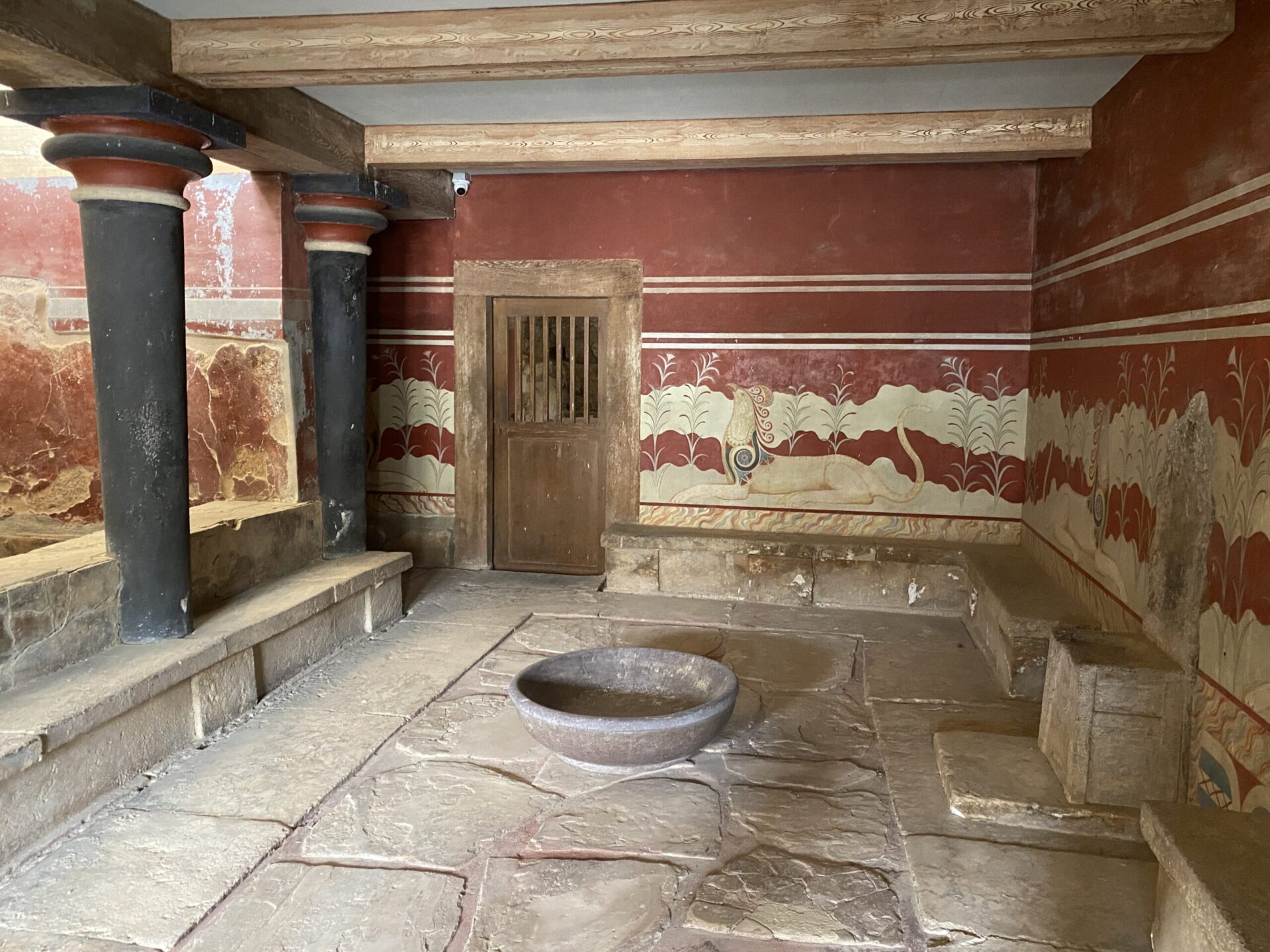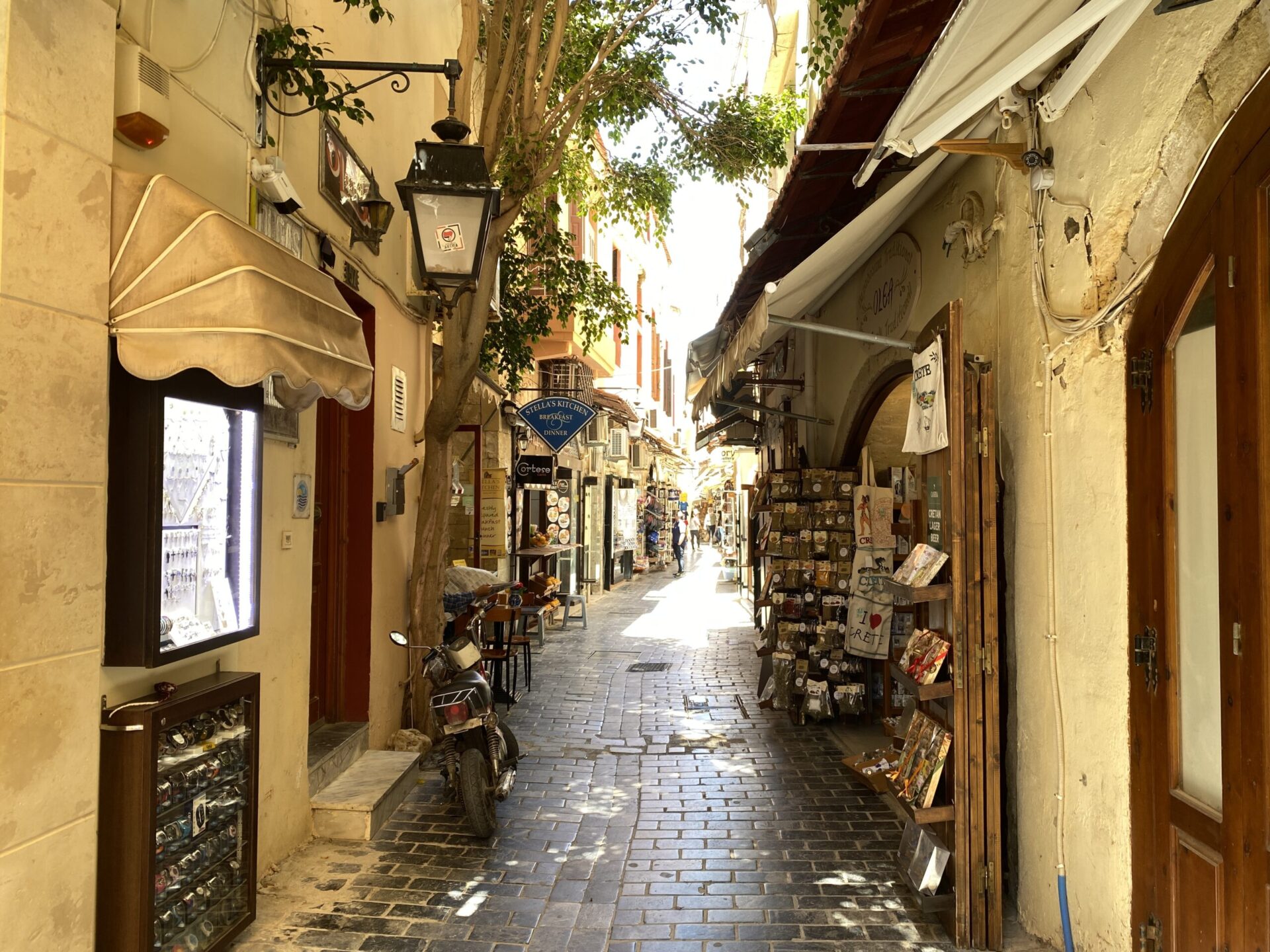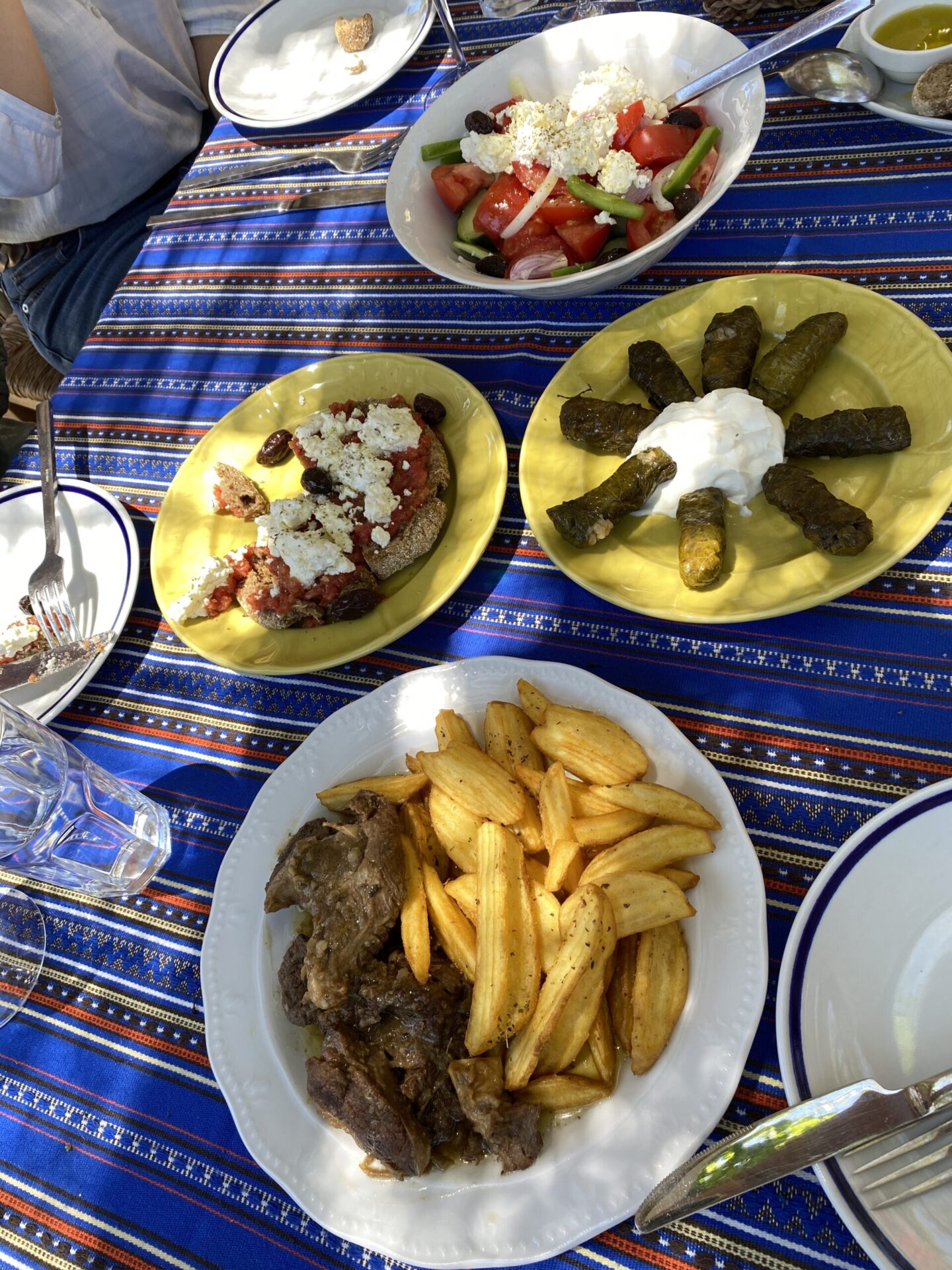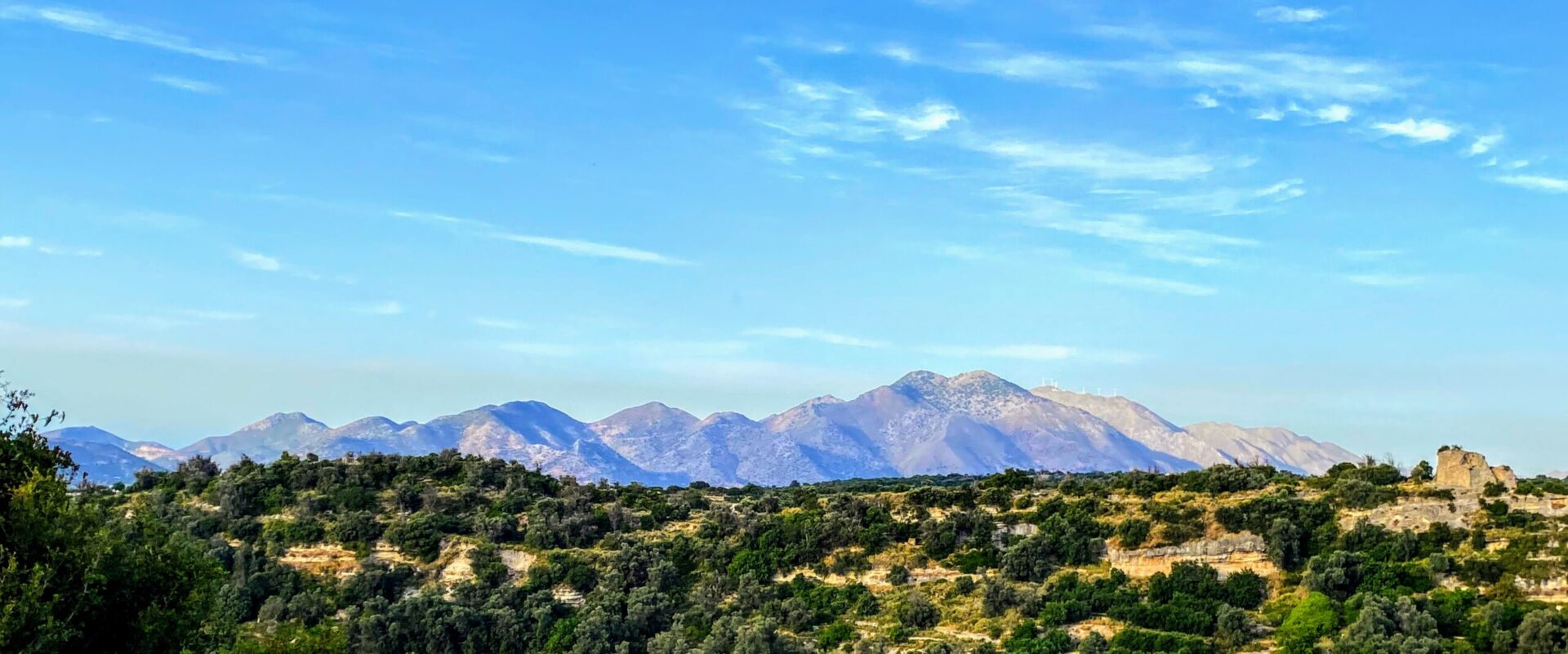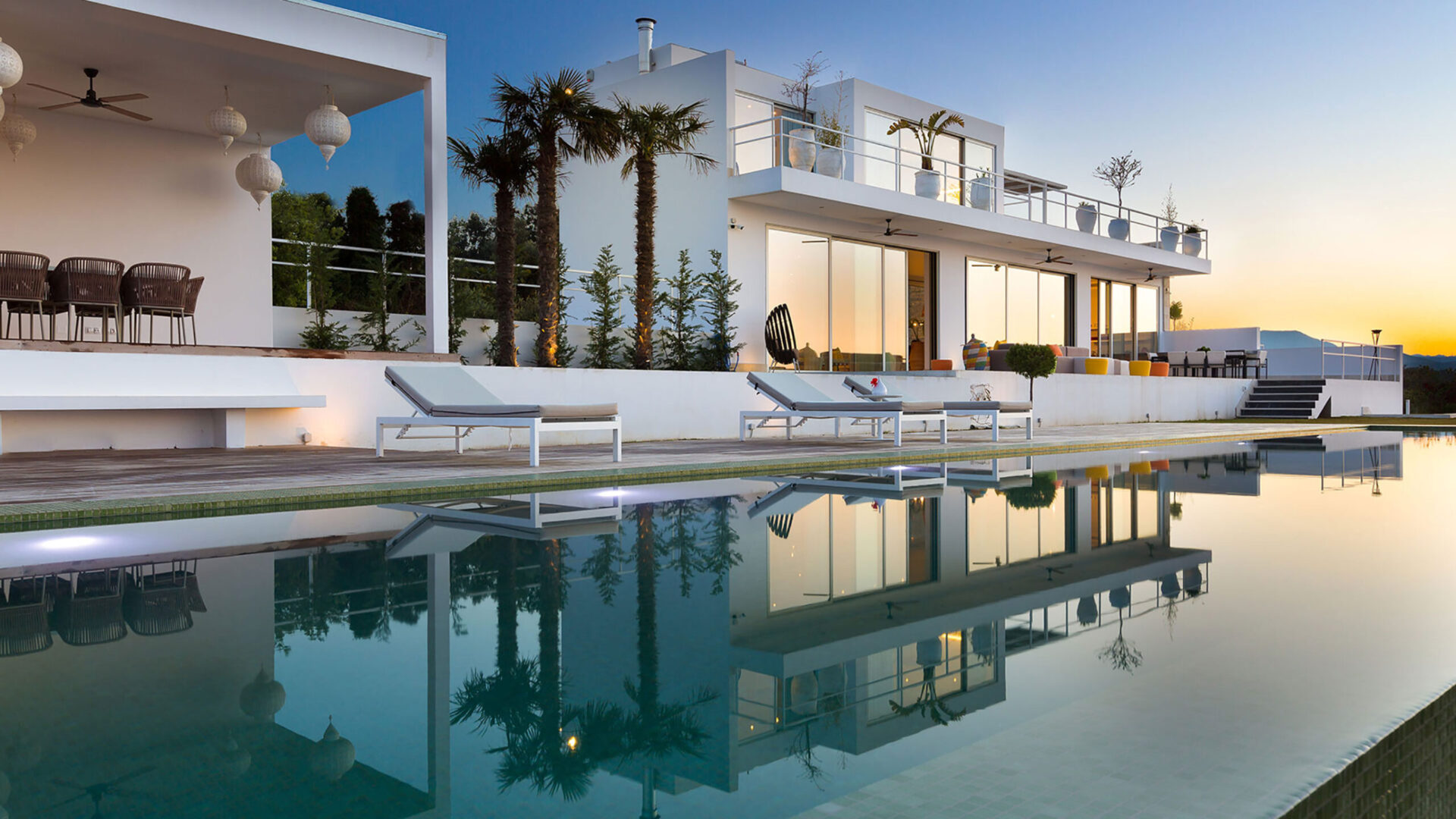The diet of Crete forms much of the basis of the now famous Mediterranean diet known for its health benefits including reduced cardiovascular disease and cancer rates. Within Greece, Crete’s cuisine stands out for its flavors and traditional dishes.
Wine and bread usually accompany lunch and dinner. Sweets and a drink of raki, a digestive, commonly end a meal. Many consider wine and olive oil the “holy alliance” in the Cretan diet, and often if you find olive trees, a vineyard is nearby. Families produce their own olive oil and wine, a tradition that continues even today.
Wines of Crete
With 6,000 years of wine making behind it, learning about Cretan wines serves as a history lesson as well. The oldest existing wine-press dates back 3,500 years. It was found in Vathipetro, near Archanes, a popular wine region of Crete. Minoan ruins have underground wine storage facilities and the Minoan traded wine and other products from Crete.
Amphora, the earthen ware jugs used for wine making and storage have also been widely found. In order to supply the Roman empire with wine, widespread cultivation of vines occurred in Crete. Later under Venetian rule, exporting of wine resumed. In 1415, records indicate over 20,000 barrels of wine exported from Crete. One hundred and fifty years later, this increased to 60,000 barrels.
The most common varietals of wine in Crete are vilana and vidiano (white) and Kotsifali (red). Syrah and Kostifali are a common blend. Liatiko, used to make a sweet desert wine served chilled, grows as well.
Raki
Tsikoudia, also known as raki, is considered the Cretan Spirit. Distilled from the must, the skins and stems left over after making wine, much like grappa, the season for making raki follows the wine harvest. Considered a brandy, raki contains about 40% alcohol. A fairly strong drink, raki quite often comes complimentary with a small desert at a restaurant when requesting the check. Raki, is generally served chilled, as it is considered a digestive. The season for making raki follows wine making, usually mid-October to early November in Crete. Tsikoudia, is a protected designation of the EU and considered original when it comes from Crete. Some commercial production exists, but most of the production is by local folks for their own consumption or serving at their restaurant. Much like the “village” wine concept, so widespread throughout Greece.
Making “Village” Raki the Traditional Way on Crete. Stems and seeds are kept for about 40 days in barrels, during which time fermentation takes place. A distillery, traditionally called a rakokazano or raki boiler, comprises sealed copper boiler(s) containing the stems and seeds, some remnant wine and water, and a series of long, copper funnels and tubes. Once the “bonfires” are lit under the copper boiler and the temperatures inside the boiler reach the requisite level, distilled liquid is collected in glass containers. A traditional rakokazano is a one man show. And, distillers are called kazanari. Nothing goes to waste in Crete. Even the fuel for the “bonfires” is recycled product in the form of crushed olive stones! No aging of the spirit occurs here, we were tasting spirit still warmed by the distillation process.
Cheesemaking on Crete
If you are seeking to try the best, traditional foods in Crete, you must try the traditional cheeses. Enjoying traditional Cretan cheeses is one of the culinary highlights of any visit to Crete. Almost all restaurants in Crete offer cheese platters, featuring a wide variety of locally-produced cheeses. You will often see it as an appetizer, as its job is to cleanse the palate and stimulate the appetite. Try it with raki, or maybe a local wine.
Sheep’s milk cheeses dominate in Crete. Goat’s milk cheeses are also popular and there is also some cow’s milk cheeses. If you’ve never tried sheep or goat’s milk cheese, then here is your opportunity. And, they are healthier cheeses than cow’s milk cheeses! Some of the more popular cheeses to look out for are:
Kefalograviera is usually made from sheep’s milk but may also contain both sheep and goat’s milk. It’s a hard table cheese and is often the cheese of choice for saganaki.
Kefalotyri is a semi-hard, salty cheese which is traditionally aged in mountain huts. It tastes a little like gruyere and is considered the ancestor cheese for all Greek, hard cheese varieties. A lovely cheese to enjoy with grapes, figs and pears, or maybe on your pizza, accompanied with some red wine, of course.
Myzithra is an unpasteurized cheese made with the whey of sheep’s cheese, although goat’s or cow’s milk is not uncommon either. You can buy it dried, but the more popular variety is the fresh cheese, which you need to consume within a couple of days. Myzithra is just glorious served with nuts and honey to enjoy at either breakfast or as a dessert!
It’s not just the cheeses that are brilliant on Crete but the yogurt as well! Try some at breakfast with honey and walnuts. Cretans love honey! One of Hippocrates foods for holistic health, honey provides many health benefits. Honey and yogurt make a simple dessert or breakfast. Raki pancakes and loukoumades are also served with honey. Thyme honey was the most common flavor we found, but there are many. Depending on the source of pollen for the bees, the health benefits of honey vary. Thyme honey, from Chania, improves the function of the respiratory system, while orange tree honey improves the circulatory system. Other varieties boost the immune system, strengthen the nervous system, provide allergy relief and many other benefits.
Loukoumades
And we end our list of traditional Cretan foods with dessert. Dessert varies from beautiful pastries made with phyllo or handspun pastry dough, to simple yogurt or cheese with honey, or just fresh fruit.
But one of my favorites is loukoumades. These are small donuts, served drizzled with honey. While found on menus throughout Greece, but they are originally from Crete.
Dakos and Rusks
Of all the traditional foods in Crete, dakos seems the most common. Dakos are Cretan barley rusks, soaked in Olive oil, then topped with chopped tomato and fresh whey cheese. Served at any meal and found in almost any restaurant on Crete.
Cretan rusks are hard, twice cooked bread originally developed as a more nutritious form of bread which would last longer and travel well for field workers. Traditionally made from wheat and/or barley flour, there is also a version made from chickpea flour.
Extremely popular, rusks are served in every bread basket at every meal in Crete providing plenty of opportunities to try them.
Olive Oil on Crete
With olive tree cultivation on Crete for over 4000 years, and over 30,000,000 olive trees, Crete knows a bit about producing top quality olive oil! The oldest olive trees on Crete are over 2,000 years old! Olive trees bloom in the Spring and the harvest begins in the autumn, usually the beginning of November, and lasts 2-3 months, but it varies based on weather and location. In a warm year, mid-October for harvest is not uncommon.
Ninety percent of the olive oil produced in Crete is extra virgin olive oil (EVOO) processed without chemical interventions. Low acidity, less than .05, rich aroma and particular flavors are characteristics of olive oil from Crete. High in antioxidants, olive oil is a healthy oil or fat.
People who follow a traditional Cretan diet, also widely known as the Mediterranean diet, have low rates of cardiovascular disease and cancer – living longer and generally healthier than others. One of the secrets seems to be eating healthy fats. In Crete, the primary source of healthy fats is olive oil. The average olive oil consumption in Crete per person annually is 35 liters! So, for a household of 4 – that is 140 liters of olive oil – almost 3 liters a week. Many people drink a shot of olive oil daily.
And as an Adventurer, you will notice how much olive oil you consume – salads, breads, meats, everything served with a generous amount of olive oil, the “Gold of Crete.”
Kali Orexi! (Bon Appetite)




